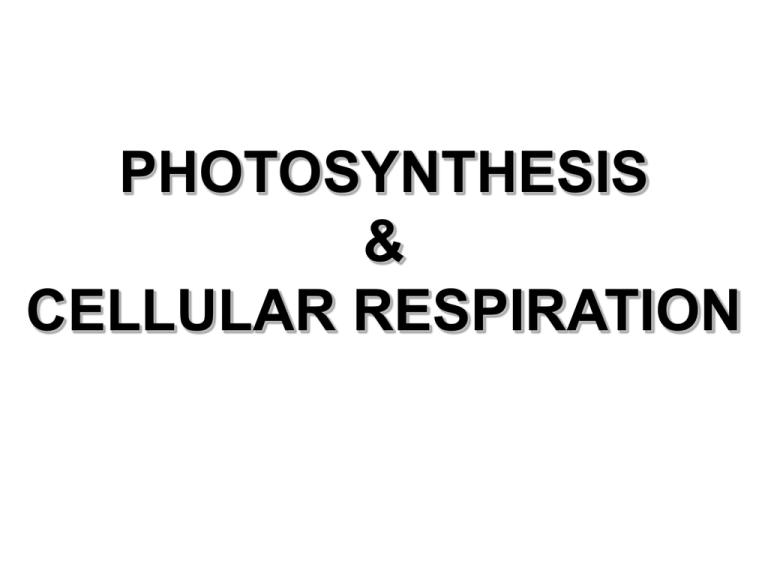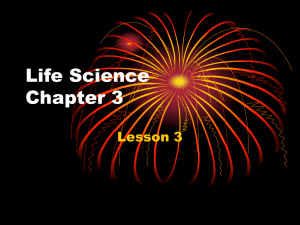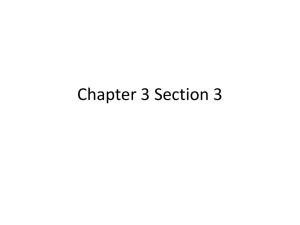Photosynthesis and respiration
advertisement

PHOTOSYNTHESIS & CELLULAR RESPIRATION Photosynthesis for Beginners • THE LIGHT REACTION (light dependent because it can only occur in the light) – Plants take in water through the roots and carbon dioxide through the stomata underneath the leaves. These travel to the stacks of thylakoids inside the chloroplast where chlorophyll molecules are found – Sunlight provides energy to split the water molecules into hydrogen ions and oxygen molecules – The oxygen molecules are then released through the stomata – Hydrogen ions are picked up by carrier molecules called NADP to make a molecule of NADPH+ Photosynthesis for Beginners – The energy of the sun in also used to excite the electrons of the chlorophyll molecule, boosting them to higher energy levels. When the electrons fall back to their original lower levels, the energy released as they fall back is used to attach a phosphate molecule to adenosine diphosphate to make adenosine triphosphate (ADP ATP) – NADPH+ and ADP diffuse out of the thylakoid to the surrounding region called “Stroma” Photosynthesis for Beginners • THE DARK REACTION (light independent reaction because it can occur with OR without light) – Carbon dioxide that is taken into the stroma through the stomata will be split by enzymes into carbon and oxygen molecules. Excess oxygen atoms are released through the stomata – NADPH+ drops off the hydrogen atoms and enzymes chemically bond one carbon, two hydrogens and one oxygen atom. This process occurs six times to create a molecule of glucose: C6H12O6 Photosynthesis for Beginners • THE BALANCED CHEMICAL EQUATION FOR PHOTOSYNTHESIS IS: 6CO2 + 6H2O C6H12O6 + 6O2 (using light, in plants with chlorophyll) Cellular Respiration for Beginners • GLYCOLYSIS (occurs in the cytoplasm) – Glucose molecules diffuse through the plasma membrane into the cytoplasm – Enzymes use two ATP molecules to split glucose into two smaller molecules with three carbons, six hydrogens, and three oxygens. – Additional enzymes convert these molecules into pyruvic acid. Four ATPs are produced (Energy in the bonds is released when atoms are separated). – If sufficient oxygen is present in the cell, pyruvic acid will diffuse into the mitochondrion and continue aerobic respiration (aerobic means with oxygen) Cellular Respiration for Beginners – If oxygen is not present in sufficient quantities, the pyruvic acid remains in the cytoplasm and begins anaerobic respiration. (anaerobic means without oxygen) • In animal cells, pyruvic acid is broken down by enzymes into lactic acid, releasing two ATP molecules. This process is called lactic acid fermentation. Lactic acid builds up creating “oxygen debt” and leaving muscles sore. Taking in O2 breaks down lactic acid. • In yeast cells, pyruvic acid is broken down by enzymes into alcohol, releasing two ATP molecules. This process is called alcohol fermentation. Alcohol builds up until it becomes toxic and kills the yeast. Cellular Respiration for Beginners • KREBS CYCLE and ELECTRON TRANSPORT CHAIN (Aerobic Respiration) – Pyruvic acid diffuses into the mitochondrion and is broken down by enzymes. – Electrons from these atoms are shuttled through membranes inside the mitochondrion building up a supply of H+ ions. As H+ ions are passed through the membranes, the energy released is used to attach phosphates to adenosine diphosphate to make 36 molecules of adenosine triphosphate (ATP) for each original molecule of glucose) – Oxygen is chemically bonded to the hydrogen ions to make water which is then released as waste during exhaling • THE BALANCED CHEMICAL EQUATION FOR CELLULAR RESPIRATION IS: C6H12O6 + 6O2 6CO2 + 6H2O + ENERGY 36ATP glucose pyruvic acid 2 ATP 2 ATP 32 ATP







